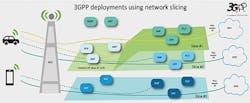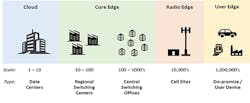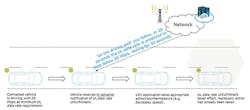Cellular-Vehicle-to-Everything (C-V2X)
Cellular-Vehicle-to-Everything (C-V2X) is at the forefront of digital transformation with operating spectrum allocated by the Federal Communications Commission (FCC), devices prepared by 5G Automotive Association (5GAA) members, and commercial launches announced by both car OEMs and road operators.
This momentum also exists in other regions, including in Asia and Europe. As C-V2X and mobile networks move into the 5G era, there will be new services supported with the new communication modes and new business opportunities available.
5GAA identified a new list of services as examples that illustrate the needs of communication requirements and intelligent transportation system (ITS) infrastructures. The review concluded that Vehicle-to-Infrastructure (V2I), which can deliver immediate benefits regardless of C-V2X penetration rate, is suitable for these new services.
There are different ways to realize the V2I services with novel approaches of deploying Roadside Units (RSUs), including mobile RSUs, distributed RSUs, and virtual RSUs. Also, the combined use of Edge Computing together with the PC5 capability for device-to-device communication to realize the V2I services is reviewed.
Vehicle-to-Network (V2N) mode uses the 5G mobile network as a complementary tool to assist the V2I with delivering some end-to-end services, and provides an alternative solution for non-delay-critical services in V2I.
More spectrum needs to be allocated in the ITS bands to support these advanced set of services. The analysis based on the review of the above services concludes that 40 MHz more spectrum needs to be allocated in ITS bands with better unlicensed out-of-band emissions (OOBE) protections.
Additional deployment considerations revealed that new business opportunities for automotive OEMs and Mobile Network Operators provide even more than devices and basic connectivity.
Overview And Importance Of C-V2X
C-V2X was developed by the telecommunications industry specifically for transportation safety applications and further standardized at the application layer by automotive and transportation stakeholders and is rapidly gaining global mindshare.
C-V2X is supported by a group of standards families:
- LTE based C-V2X, as specified in 3GPP Release 14 (published in 2017), and Release 15 (published in 2018). [1]
- 5G and NR based C-V2X, as specified in 3GPP Rel-16 (published in 2020) and with continuing evolution with further releases. [2]
- Applications and protocols developed by SAE. [3]
C-V2X supports 2 modes of communications:
- Direct (PC5/Sidelink): The direct mode of C-V2X does not require that cellular networks offer data communication service, although end-to-end use cases can be complemented by mobile networks. This is currently adopted by the automotive industry and provides an improved message delivery mechanism for Vehicle-to-Vehicle (V2V), Vehicle-to-Pedestrian (V2P), and Vehicle-to-Infrastructure (V2I) applications to improve road safety and traffic efficiencies in the harmonized 5.9GHz ITS band.
- Mobile network based (Uu): Cellular network connectivity (Uu mode of C-V2X) — often referred as Vehicle-to-Network (V2N) — is commonly used for telematics services. It first debuted in automotive applications in 1996 and has steadily increased across vehicle makes and models. Over the last few telematics design-cycles, automakers have increased communication technology adoption, and are rapidly moving to achieve 100% attach rates.
This offers connected vehicles a variety of use cases ranging from automotive crash notification (ACN), concierge services, firmware updates, connected infotainment, traffic and road condition updates, and remote supervisory control.
The 2 modes of C-V2X synergize in an integrated form, like in the same chipsets and platforms. This allows automakers to plan their new products with unified technology trajectories for improved performance and functionality as well as strong cost benefits. The complementary nature of each mode of communication can deliver a richer experience for end-to-end use cases by leveraging both local short-range and long-range connectivity. Additionally, vehicles can utilize the network to assist the scheduling of direct mode C-V2X for better radio resource efficiency when within coverage.
Infrastructure owner-operators and mobile network operators recognize comparable synergy as the infrastructure ecosystem features high-density 5G network deployment. Operators can integrate the functionality required for V2I applications with 5G infrastructure. Alternatively, RSUs deployed to improve road safety can include the necessary functionality to support 5G network infrastructure build-out and densification and to yield win-win opportunities for public-private partnerships.
Business Models For MNOs
MNOs can utilize new business models to interact with the automotive industry to ensure that C-V2X services reach their full potential. Network slicing is likely a key component allowing MNOs to consistently meet the diverse requirements of automotive OEMs that span safety, convenience, and efficiency use cases. The goal of network slicing is to allow MNOs to operate multiple logical networks, or slices, using their common infrastructure to serve multiple customers while simultaneously isolating the network slices to ensure specific SLAs.
Figure 1 shows a high-level view of network slicing: 2 automotive network slices, and 1 network slice for mobile phones. Network slicing provides distinct advantages over dedicated network solutions regarding increased flexibility and lower costs.
Offering different slices of the mobile network based on specific service requirements of the end customer also gives MNOs the power to differentiate pricing and better monetize the full extent of their network capabilities. For example, a network slice targeting safety-related use cases with low latency and high reliability could provide higher value to the end user than a high latency and lower reliability slice for convenience use cases.
In addition to network slicing, MNOs can offer a unique set of tools that enhances the automotive industry’s C-V2X service utility. Rather than providing complete services or product solutions, these tools likely serve as the foundations of advanced V2X services required by the automotive industry and offer additional monetization pathways for MNOs.
Edge computing is a significant tool that can reduce latency for C-V2X use cases requiring computation by relocating those computations closer to the end user rather than existing in a distant public cloud data center.
Additionally, edge computing allows for the pooling and coordination of data at the local or even regional levels for analysis and actionable intelligence for C-V2X services.
By keeping the computational resources within the confines of their own networks, MNOs are also able to achieve greater control and improve service level reliability.
MNOs’ existing nationwide infrastructure portfolio offers numerous points of presence that could be utilized for edge computing, as shown in Figure 2 from 5G Americas’ whitepaper, 5G Services Innovation.
Notably, switching offices could offer edge computing services to the automotive industry. Infrastructure at the Core Edge level offers a beneficial tradeoff between a sufficient distribution of available sites to ensure that computing resources are located close to the end users while also maintaining a scale that balances the economic costs with the provided benefits.
In contrast, the economic costs of providing edge computing services at tens of thousands of radio access network (RAN) sites, or the Radio Edge, would likely be cost-prohibitive for today’s C-V2X use cases. For truly delay-stringent services where each millisecond matters, the computation would be done at the User Edge, within the vehicle subsystems and chipsets.
Another Tool Offered By MNOs Is Predictive Quality Of Service
Predictive Quality of Service (PQoS) is needed due to the complex/non-deterministic nature of mobile networks and road traffic conditions. While MNOs make their best effort to provide consistent network experiences and high reliability, total consistency is rarely obtainable in practical application. This is important for vehicles that rely on connectivity with a mobile network for the functionality of various C-V2X use cases. The vehicle needs to confirm that the desired level of mobile network connectivity is feasible throughout the future route for a variety of reasons. Knowledge of this ahead of time allows the vehicle to react proactively and prepare accordingly, including altering transmission of data or even modifying its route.
Figure 3 depicts potential PQoS utilization by a C-V2X application for proactive action and mitigation for the impact of reduced mobile network performance. By making PQoS information available, MNOs can deliver an important tool that automotive OEMs and suppliers can utilize to more effectively implement C-V2X services. MEC architectures can also be utilized to provide on-demand notification messages about the predicted QoS based on current network KPIs.
For many C-V2X services and advanced driver assistance systems (ADAS), awareness of a vehicle’s absolute position (latitude, longitude, and elevation) is critical for determining a vehicle’s precise location. The Global Navigation Satellite System (GNSS) is used by vehicles to obtain their absolute location, but its self-determined accuracy (~3-10m), is often insufficient for V2X use cases. Higher level accuracy (precise positioning) requires reference stations on Earth that are used to correct for the inherent atmospheric, satellite orbit, and timing errors. The reference stations can be used to calculate corrections to the GNSS signals that are received by vehicles to unlock more accurate location.
Real-Time Kinematic (RTK) is a precise location technique that can ideally achieve accuracy down to the cm-level. Precise Point Positioning – Real-Time Kinematic (PPP-RTK) is a related technique that can obtain accuracy of ~10cm over larger areas with fewer reference stations. [47] MNOs can play a key role in these location techniques by serving as a distribution channel for the vehicle’s position corrections by utilizing either the user or control planes.
As the density of vehicles needing precise positioning grows, scalable and efficient precise positioning mechanisms based on common standards is important for MNOs and the automotive ecosystem.
Finally, MNOs offer a critical piece of the puzzle for C-V2X service realization: cross-MNO support. With different automotive OEMs being supported by different MNOs and the additional flexibility provided by eSIM technology, there is a critical need for V2N services to function across multiple MNOs. Cross-MNO support ensures that the full benefits of C-V2X services are realized at the greatest scale possible. This is especially true for use cases requiring data pooling and information sharing that benefits from the inclusion of all possible vehicles.
Conclusion
Imagine a future where vehicles are not only fully aware of their surroundings but can also see around corners to predict potential accidents. Imagine that drivers would witness vehicles evolving to seamlessly communicate with each other and virtually everything around them. C-V2X technology ushers in new levels of safety and connectivity and bring vehicles even closer to autonomy — all while creating a diverse ecosystem that drives the future of smart transportation.
Resources and Notes
This article and all source information is found in and adapted from the white paper Vehicular Connectivity: C-V2X & 5G, A 5G Americas White Paper, September 2021. To download the white paper, please visit https://www.5gamericas.org/vehicular-connectivity-c-v2x-and-5g/.
Please visit https://www.5gamericas.org/5g-connecting-the-car/ for a companion blog post by Chris Pearson on the white paper.
For more information, email [email protected] or visit https://www.5gamericas.org/. Follow 5G Americas on Twitter @5GAmericas.
About the Author




